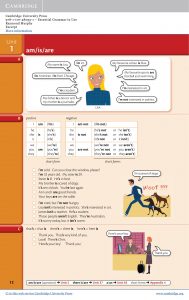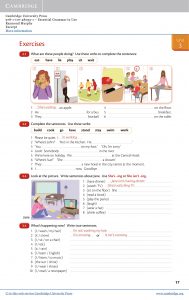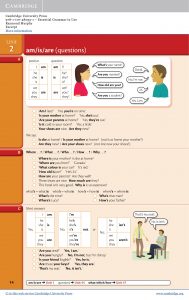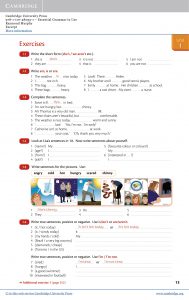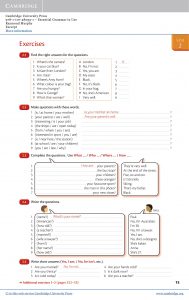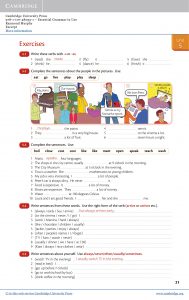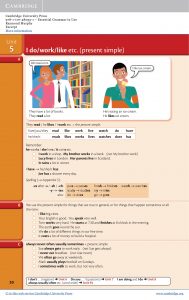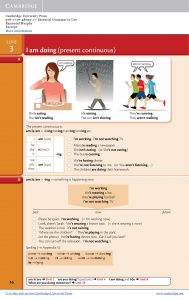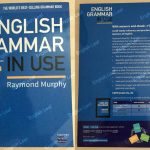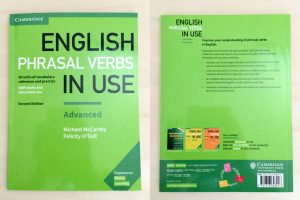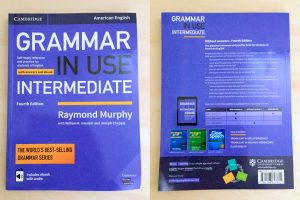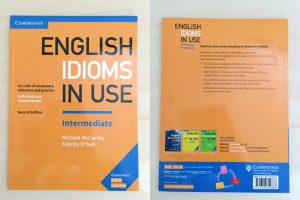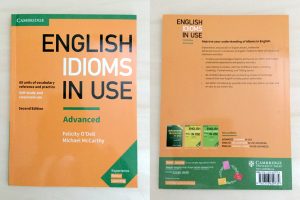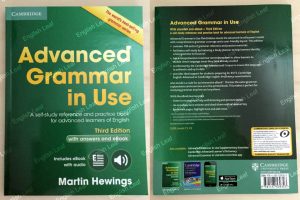文法書のバイブル! English Grammar in Useシリーズの種類と選び方も確認する。
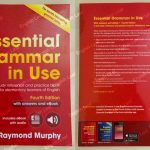
Contents
Acknowledgements
To the student
To the teacher
Interactive eBook
Present
1 am/is/are
2 am/is/are (questions)
3 I am doing (present continuous)
4 are you doing? (present continuous questions)
5 I do/work/like etc. (present simple)
6 I don’t … (present simple negative)
7 Do you … ? (present simple questions)
8 I am doing (present continuous) and I do (present simple)
9 I have … and I’ve got …
Past
10 was/were
11 worked/got/went etc. (past simple)
12 I didn’t … Did you … ? (past simple negative and questions)
13 I was doing (past continuous)
14 I was doing (past continuous) and I did (past simple)
Present perfect
15 I have done (present perfect 1)
16 I’ve just … I’ve already… I haven’t … yet (present perfect 2)
17 Have you ever … ? (present perfect 3)
18 How long have you … ? (present perfect 4)
19 for since ago
20 I have done (present perfect) and I did (past)
Passive
21 is done was done (passive 1)
22 is being done has been done (passive 2)
Verb forms
23 be/have/do in present and past tenses
24 Regular and irregular verbs
Future
25 What are you doing tomorrow?
26 I’m going to…
27 will/shall 1
28 will/shall 2
IF YOU ARE NOT SURE WHICH UNITS TO STUDY, USE THE STUDY GUIDE ON PAGE 271
Modals, imperative etc.
29 might
30 can and could
31 must mustn’t don’t need to
32 should
33 I have to …
34 Would you like …? I’d like…
35 Do this! Don’t do that! Let’s do this!
36 I used to …
There and it
37 there is there are
38 there was/were there has/have been there will be
39 It …
Auxiliary verbs
40 I am, I don’t etc.
41 Have you? Are you? Don’t you? etc.
42 too/either so am I/neither do I etc.
43 isn’t, haven’t don’t etc. (negatives)
Questions
44 is it … ? have you … ? do they … ? etc. (questions 1)
45 Who saw you? Who did you see? (questions 2)
46 Who is she talking to? What is it like? (questions 3)
47 What …? Which …? How …? (questions 4)
48 How long does it take … ?
49 Do you know where …? I don’t know what … etc.
Reported speech
50 She said that … He told me that …
-ing and to …
51 work/working go/going do/doing
52 to… (I want to do) and -ing (I enjoy doing)
53 I want you to … I told you to …
54 I went to the shop to …
Go, get, do, make and have
55 go to … go on… go for … go-ing
56 get
57 do and make
58 have
Pronouns and possessives
59 l/me he/him they/them etc.
60 my/his/their etc.
61 Whose is this? It’s mine/yours/hers etc.
62 l/me/my/mine
63 myself/yourself/themselves etc.
64 -‘s (Kate’s camera / my brother’s car etc.)
IF YOU ARE NOT SURE WHICH UNITS TO STUDY, USE THE STUDY GUIDE ON PAGE 271
A and the
65 a/an…
66 train(s) bus(es) (singular and plural)
67 a bottle / some water (countable/uncountable 1)
68 a cake / some cake / some cakes (countable/uncountable 2)
69 a/an and the
70 the…
71 go to work go home go to the cinema
72 I like music I hate exams
73 the… (names of places)
Determiners and pronouns
74 this/that/these/those
75 one/ones
76 some and any
77 not + any no none
78 not + anybody/anyone/anything nobody/no-one/nothing
79 somebody/anything/nowhere etc.
80 every and all
81 all most some any no/none
82 both either neither
83 a lot much many
84 (a) little (a) few
Adjectives and adverbs
85 old/nice/interesting etc. (adjectives)
86 quickly/badly/suddenly etc. (adverbs)
87 old/older expensive / more expensive
88 older than … more expensive than …
89 not as … as
90 the oldest the most expensive
91 enough
92 too
Word order
93 He speaks English very well. (word order 1)
94 always/usually often etc. (word order 2)
95 still yet already
96 Give me that book! Give it to me!
Conjunctions and clauses
97 and but or so because
98 When …
99 If we go … If you see … etc.
100 If I had … If we went … etc.
101 a person who … a thing that/which … (relative clauses 1)
102 the people we met the hotel you stayed at (relative clauses 2)
IF YOU ARE NOT SURE WHICH UNITS TO STUDY, USE THE STUDY GUIDE ON PAGE 271
Prepositions
103 at 8 o’clock on Monday in April
104 from … to until since for
105 before after during while
106 in at on (places 1)
107 in at on (places 2)
108 to in at (places 3)
109 under, behind, opposite etc.
110 up, over, through etc.
111 on at by with about
112 good at …, interested in … etc. of/at/for etc. (prepositions) +-ing
113 listen to … , look at … etc. (verb + preposition)
Phrasal verbs
114 go in, fall off, run away etc. (phrasal verbs 1)
115 put on your shoes put your shoes on (phrasal verbs 2)
Appendices
Appendix 1 Active and passive
Appendix 2 List of irregular verbs
Appendix 3 Irregular verbs in groups
Appendix 4 Short forms (he’s / I’d / don’t etc.)
Appendix 5 Spelling
Appendix 6 Phrasal verbs (take off / give up etc.)
Appendix 7 Phrasal verbs + object (put out a fire / give up your job etc.)
Additional exercises
Study guide
Key to Exercises
Key to Additional exercises
Key to Study guide
Index
IF YOU ARE NOT SURE WHICH UNITS TO STUDY, USE THE STUDY GUIDE ON PAGE 271
Acknowledgements
Design
Kamae Design
Illustrations Adz, Paul Boston, Christopher Flint, John Goodwin, Katie Mac, Martina – KJA artists, Lucy Truman
Digital development
Datamatics Ltd.
To the student (working without a teacher)
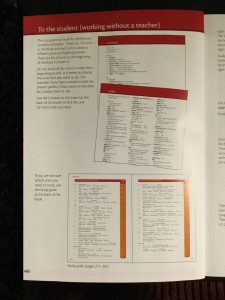
This is a grammar book for elementary students of English. There are 115 units in the book and each unit is about a different point of English grammar. There is a list of units at the beginning of the book (Contents).
Do not study all the units in order from beginning to end. It is better to choose the units that you need to do. For example, if you have a problem with the present perfect (I have been, he has done etc.), study Units 15-20.
Use the Contents or the Index (at the back of the book) to find the unit (or units) that you need.
If you are not sure which units you need to study, use the Study guide at the back of the book
Study guide (pages 271-282)
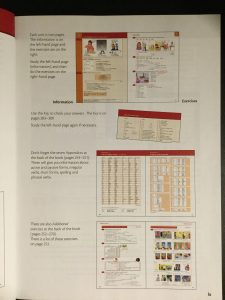
Each unit is two pages. The information is on the left-hand page and the exercises are on the right:
Study the left-hand page (information), and then do the exercises on the right-hand page.
Use the key to check your answers. The Key is on pages 283-309.
Study the left-hand page again if necessary.
Don’t forget the seven Appendices at the back of the book (pages 243-251). These will give you information about active and passive forms, irregular verbs, short forms, spelling and phrasal verbs.
There are also Additional exercises at the back of the book (pages 252-270). There is a list of these exercises on page 252
To the teacher
The most important features of this book are:
It is a grammar book. It does not deal with other aspects of the language.
It is for elementary learners. It does not cover areas of grammar which are not normally taught at elementary level.
It is a reference book with exercises. It is not a course book and is not organised progressively.
It is addressed to learners and intended for self-study.
Organisation of the book
There are 115 units in the book, each one focusing on a particular area of grammar. The material is organised in grammatical categories, such as tenses, questions and articles. Units are not ordered according to difficulty. and should therefore be selected and used in the order appropriate for the learner(s). The book should not be worked through from beginning to end.
The units are listed in the Contents and there is a comprehensive Index at the end of the book.
Each unit has the same format consisting of two facing pages. The grammar point is presented and explained on the left-hand page and the corresponding exercises are on the right. There are seven Appendices (pages 243-251) dealing with active and passive forms, irregular verbs, short forms (contractions), spelling and phrasal verbs. It might be useful for teachers to draw students’ attention to these.
At the back of the book there is a set of Additional exercises (pages 252-270). These exercises provide ‘mixed’ practice bringing together grammar points from a number of different units (especially those concerning verb forms). There are 35 exercises in this section and there is a full list on page 252.
Also at the back of the book there is a Study guide to help students decide which units to study – see page 271.
Finally, there is a key (pages 283-309) for students to check their answers to all the exercises in the book. An edition without the Study guide and Key is available for teachers who would prefer it for their students.
Level
The book is for elementary learners, i.e. learners with very little English, but not for complete beginners. It is intended mainly for elementary students who are beyond the early stages of a beginners’ course. It could also be used by low-intermediate learners whose grammar is weaker than other aspects of their English or who have problems with particular areas of basic grammar.
The explanations are addressed to the elementary learner and are therefore as simple and as short as possible. The vocabulary used in the examples and exercises has also been restricted so that the book can be used at this level.
Using the book
The book can be used by students working alone (see To the student) or as supplementary course material. In either case the book can serve as an elementary grammar book.
When used as course material, the book can be used for immediate consolidation or for later revision or remedial work. It might be used by the whole class or by individual students needing extra help and practice.
In some cases it may be desirable to use the left-hand pages (presentation and explanation) in class, but it should be noted that these have been written for individual study and reference. In most cases, it would probably be better for teachers to present the grammar point in their preferred way with the exercises being done for homework. The left-hand page is then available for later reference by the student.
Some teachers may prefer to keep the book for revision and remedial work. In this case, individual students or groups of students can be directed to the appropriate units for self-study and practice.
Interactive eBook
You can buy this book with or without an eBook. The eBook has the same grammar explanations and exercises as the book
.
Using the eBook
You can use your eBook on an iPad, Android tablet, PC or Mac.
Using the eBook you can:
Listen to examples
Save your answers
Make notes
Highlight text
Bookmark pages
Use the dictionary
How to get your eBook
Follow the instructions in the inside front cover of this book.
CAMBRIDGE UNIVERSITY PRESS
サンプルページEssential Grammar in Use
文法書のバイブル! English Grammar in Useシリーズの種類と選び方
も確認する。
